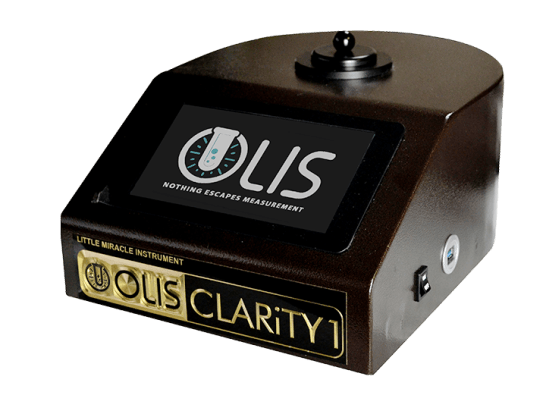The Greatest Guide To Circular Dichroism
Wiki Article
Some Known Details About Circular Dichroism
Table of ContentsThe 5-Second Trick For Circularly Polarized LuminescenceCircular Dichroism Fundamentals ExplainedThe Ultimate Guide To Circular DichroismUv/vis Things To Know Before You BuySome Known Details About Circular Dichroism Getting The Uv/vis To WorkAll About Circularly Polarized LuminescenceSome Known Factual Statements About Circularly Polarized Luminescence The 3-Minute Rule for SpectrophotometersAll about Circularly Polarized LuminescenceThe Ultimate Guide To Uv/vis/nirUv/vis - QuestionsExamine This Report about Circularly Polarized Luminescence
It is then scanned through the sample and the recommendation solutions. Portions of the event wavelengths are sent through, or shown from, the sample and the recommendation. The resultant light strikes the photodetector device, which compares the relative strength of the two beams. Electronic circuits transform the relative currents into linear transmission portions and/or absorbance/concentration values.The transmission of a referral compound is set as a baseline (datum) worth, so the transmission of all other substances are taped relative to the initial "zeroed" compound. The spectrophotometer then converts the transmission ratio into 'absorbency', the concentration of particular components of the test sample relative to the preliminary substance.
Because samples in these applications are not readily offered in big quantities, they are specifically fit to being examined in this non-destructive method. In addition, precious sample can be conserved by using a micro-volume platform where just 1u, L of sample is needed for total analyses. A brief explanation of the treatment of spectrophotometry consists of comparing the absorbency of a blank sample that does not contain a colored substance to a sample which contains a colored substance.
Circularly Polarized Luminescence Can Be Fun For Anyone
In biochemical experiments, a chemical and/or physical home is selected and the treatment that is used is specific to that residential or commercial property in order to derive more details about the sample, such as the quantity, pureness, enzyme activity, etc. Spectrophotometry can be used for a variety of methods such as identifying ideal wavelength absorbance of samples, figuring out optimum p, H for absorbance of samples, determining concentrations of unknown samples, and figuring out the p, Ka of various samples.: 21119 Spectrophotometry is likewise a valuable process for protein filtration and can likewise be used as a technique to create optical assays of a substance.It is possible to understand the concentrations of a 2 part mix utilizing the absorption spectra of the basic services of each component. To do this, it is required to understand the termination coefficient of this mix at 2 wave lengths and the extinction coefficients of services that include the recognized weights of the 2 components.

Rumored Buzz on Spectrophotometers
Area. The concentration of a protein can be estimated by determining the OD at 280 nm due to the existence of tryptophan, tyrosine and phenylalanine.This method needs a spectrophotometer capable of measuring in the UV area with quartz cuvettes.: 135 Ultraviolet-visible (UV-vis) spectroscopy involves energy levels that excite electronic shifts. Absorption of UV-vis light thrills particles that are in ground-states to their excited-states.
These curves can be utilized to check a brand-new batch of colorant to examine if it makes a match to specs, e
Traditional visible conventional spectrophotometers area not detect if spot colorant or the base material has fluorescence. This can make it tough to handle color concerns if for example one or more of the printing inks is fluorescent. There are 2 significant setups for visual spectrum spectrophotometers, d/8 (round) and 0/45.
Scientists utilize this instrument to determine the amount of compounds in a sample. In the case of printing measurements 2 alternative settings are commonly utilized- without/with uv filter to manage much better the impact of uv brighteners within the paper stock.
Not known Details About Circularly Polarized Luminescence
Some applications require small volume measurements which can be carried out with micro-volume platforms. As explained in the applications area, spectrophotometry can be used in both qualitative and quantitative analysis of DNA, RNA, and proteins. Qualitative analysis can be utilized and spectrophotometers are utilized to record spectra of compounds by scanning broad wavelength regions to identify the absorbance properties (the intensity of the color) of the compound at each wavelength.
Circularly Polarized Luminescence Things To Know Before You Buy
One significant aspect is the type of photosensors that are offered for various spectral regions, however infrared measurement is likewise tough since essentially whatever emits IR as thermal radiation, especially at wavelengths beyond about 5 m. Another problem is that many materials such as glass and plastic soak up infrared, making it incompatible as an optical medium.Samples for IR spectrophotometry may be smeared between 2 discs of potassium bromide or ground with potassium bromide and pushed into a pellet. Where aqueous options are to be determined, insoluble silver chloride is utilized to build the cell. Spectroradiometers, which run nearly like the noticeable region spectrophotometers, are developed to measure the spectral density of illuminants. 2013. p. 13. Allen, DW; Cooksey, C; Tsai, BK (Nov 13, 2009). "Spectrophotometry". Recovered Dec 23, 2018. Ninfa AJ, Ballou DP, Benore M (2010 ). Basic Laboratory Techniques for Biochemistry and Biotechnology (second ed.). Hoboken: Wiley & Sons. ISBN 9780470087664. OCLC 488246403. Schwedt G (1997 ). The vital guide to analytical chemistry.
Oke, J. B.; Gunn, J. E.
More About Circularly Polarized Luminescence

Ninfa AJ, Ballou DP, Benore M (2015 ). Fundamental Lab Methods for Biochemistry and Biotechnology (3, rev. ed.). circularly polarized luminescence. Lab Equipment.
Circularly Polarized Luminescence - Truths
Retrieved Jul 4, 2018. Trumbo, Toni A.; Schultz, Emeric; Borland, Michael G.; Pugh, Michael Eugene (April 27, 2013). "Applied Spectrophotometry: Analysis of a Biochemical Mixture". Biochemistry and Molecular Biology Education. 41 (4 ): 24250. doi:10. 1002/bmb. 20694. PMID 23625877. (PDF). www. mt.com. Mettler-Toledo AG, Analytical. 2016. Recovered Dec 23, 2018. Cortez, C.; Szepaniuk, A.; Gomes da Silva, L."Exploring Proteins Filtration Methods Animations as Tools for the Biochemistry Mentor". Journal of Biochemistry Education. 8 (2 ): 12. doi:. Garrett RH, Grisham CM (2013 ). Biochemistry. Belmont, CA: Cengage. p. 106. ISBN 978-1133106296. OCLC 801650341. Holiday, Ensor Roslyn (May 27, 1936). "Spectrophotometry of proteins". Biochemical Journal. 30 (10 ): 17951803. doi:10. 1042/bj0301795.
PMID 16746224. Hermannsson, Ptur G.; Vannahme, Christoph; Smith, Cameron L. C.; Srensen, Kristian T.; Kristensen, Anders (2015 ). "Refractive index dispersion picking up utilizing an array of photonic crystal resonant reflectors". Applied Physics Letters. 107 (6 ): 061101. Bibcode:2015 Ap, Ph, L. 107f1101H. doi:10. 1063/1. 4928548. S2CID 62897708. Mavrodineanu R, Schultz JI, Menis O, eds.
Everything about Uv/vis
U.S. Department of Commerce National Bureau of Standards special publication; 378. Washington, D.C.: U.S. National Bureau of Standards. p. 2. OCLC 920079.The process begins with a controlled light that lights up the evaluated sample. In the case of reflection, as this light engages with the sample, some is taken in or discharged. The discharged light journeys to the detector, which is examined, measured, and presented as industry-standard color scales and indices.
All terms are assessed over the noticeable spectrum from 400 to 700 nm. In the case of transmission, when the light connects with the sample, it is either absorbed, reflected, or transferred.
What Does Spectrophotometers Do?
Examples consist of APHA (American Public Health Association) for watercolor and pureness analysis, ASTM D1500 for petrochemical color analysis, edible oil indices used in food, and color analyses of beverages. The simplified mathematics looks like this:. Where T is the transmission coefficient. All terms are evaluated over the visible spectrum from 400 to 700 nm.Image Credit: Matej Kastelic/ Dr. Arnold J. Beckman and his colleagues at the National Technologies Laboratories initially invented the spectrophotometer in 1940. In 1935 Beckman established the business, and the discovery of the spectrophotometer was their most ground-breaking invention. Dr. Bruce Merrifield, a Nobel prize-winning biochemist, mentioned that the invention of the spectrophotometer was "most likely the most essential instrument ever developed towards the advancement of bioscience." Before the discovery of the spectrophotometer, chemical analyses took weeks to finish, with 25% precision.
Not known Facts About Spectrophotometers
Over time, scientists kept enhancing the spectrophotometer design to enhance its efficiency. The UV capabilities of the design B spectrophotometer were enhanced by replacing the glass prism with a quartz prism.After 1984, double-beam versions of the like this gadget were created. The addition of external software application with the provision of onscreen display screens of the spectra can be found in the 1990s. Generally, a spectrophotometer is made up of two instruments, specifically, a spectrometer and a photometer. A fundamental spectrophotometer contains a source of light, a monochromator, a collimator for straight light beam transmission, a cuvette to place a sample, and a photoelectric detector.
Uv/vis Things To Know Before You Buy
There are various types of spectrophotometers in numerous shapes and sizes, each with its own function or functionality. A spectrophotometer figures out how much light is shown by chemical elements. spectrophotometers. It measures the distinction in light intensity based upon the overall amount of light presented to a sample and the amount of light beam that goes through the sample solution
A spectrophotometer is used to identify the concentration of both colorless and colored solutes in an option. This instrument is utilized to determine the rate of a response.
Report this wiki page